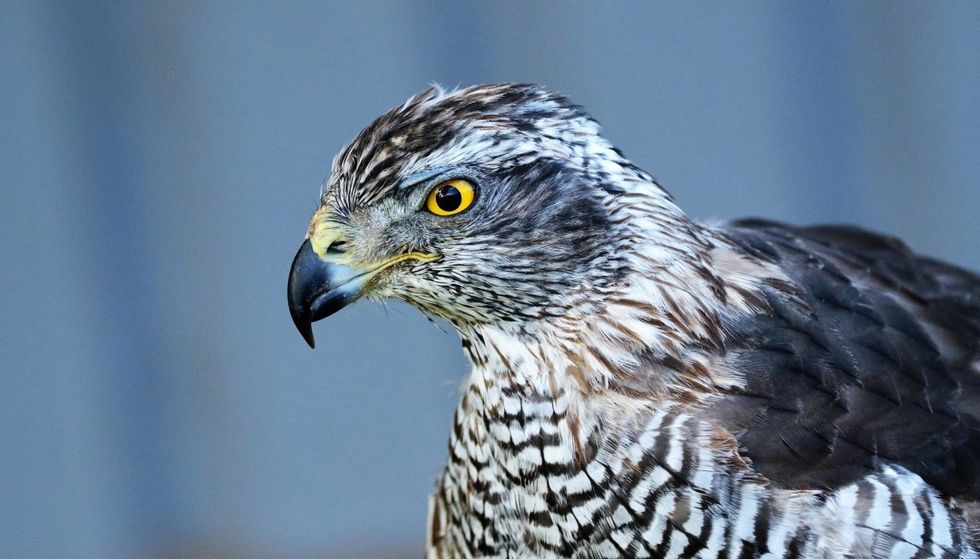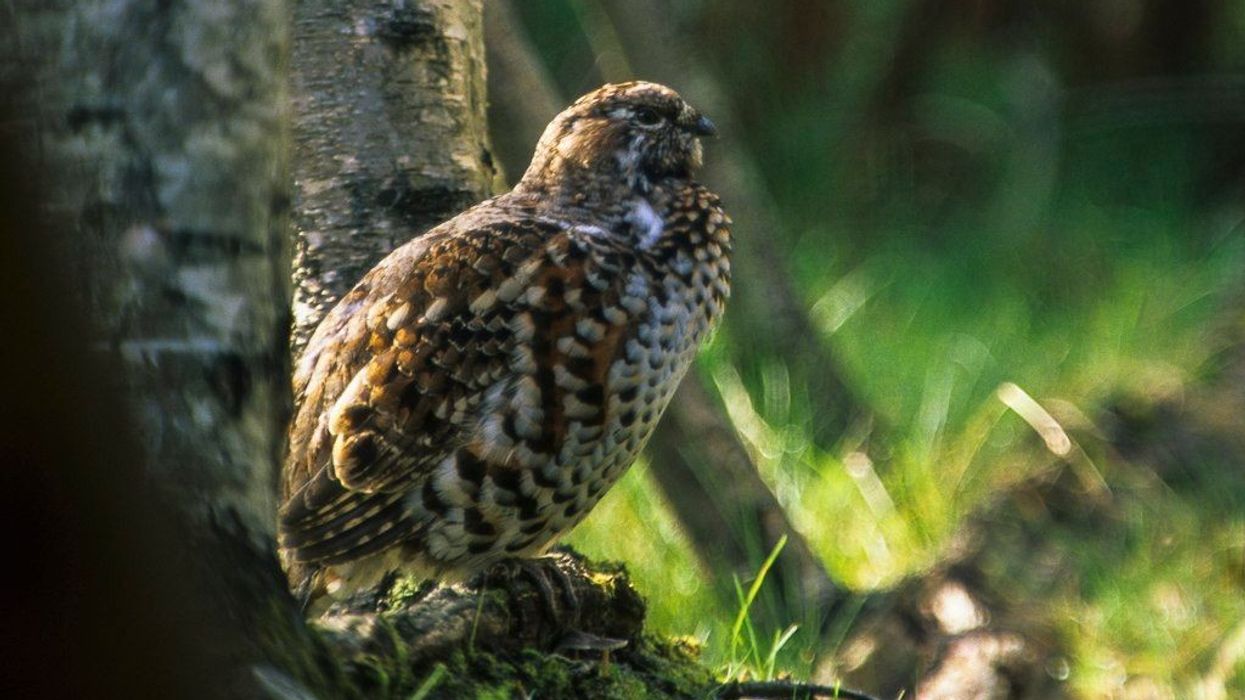Goshawks are diurnal raptors of the Accipitridae family. These accipiters have a number of species under them but northern goshawks (Accipiter gentilis) are the most common ones and are simply referred to as goshawks as a whole.
Some other goshawks, like the crested goshawk and the African goshawk, are found in Asia and Africa respectively. The goshawk pronunciation is as follows, 'gaus-hawk'.
Northern goshawks are well distributed all over Europe and North America. Different species of goshawk are distributed all over the world both in the northern and southern hemispheres.
The population density of the northern goshawks is thicker in the western European countries than in the eastern part of the continent. A northern goshawk's nesting depends on the characteristics of a tree rather than the tree itself.
Northern goshawks are found in flight normally at higher altitudes. These birds show partial migratory behavior in winters and move to the warmer tropical forests at lower altitudes.
They are one of the best options for falconry which makes them so different from other raptors. If you are interested in wildlife and want to know more about this bird then you might like these fascinating facts.
Check out articles on the house wren and the Muscovy duck.
Goshawk Interesting Facts
What type of animal is a goshawk?
The goshawk is a type of raptor bird (bird of prey) belonging to the Accipitridae family.
What class of animal does a goshawk belong to?
The northern goshawk (Accipiter gentilis) or simply goshawk belongs to the class Aves.
How many goshawks are there in the world?
It is assumed that there are 150,000-300,000 birds present all over North America. 107 nesting territories were spotted in various regions.
Their populations are denser towards the southern and western zone than in the northern parts. Europe is known to have a greater population density of these birds than North America. The global population of this species as estimated by the International Union for Conservation of Nature or IUCN is around 1-2.5 million individuals.
Where does a goshawk live?
The Accipiter gentilis or northern goshawks cover most of the countries of Europe except Iceland and Ireland. In Europe, these birds are commonly found in France, Germany, Spain, and Great Britain.
The Eurasian population is measured by the number of northern goshawks present in Russia and the range extends to Siberia. In Siberia, they are called Siberian goshawk.
In the south, the northern goshawk range extends to the northwestern parts of countries like Morocco, the islands of Sardinia and Corsica, southern Greece, Italy, Turkey, the western part of Japan and China, and parts of Tibet and the Himalayas. They are rarely found further down south.
In North America, these birds cover the western part of the United States and Canada. These North American birds are rare further east of the United States and in the mid-west region of North America.
However, northern goshawks are natives of most parts of Canada. Some parts of North America fall under the breeding regions of these birds.
In the United States, their breeding range extends from Washington state to California in the south and from Colorado in the east to Texas in the west. A small breeding population is also present in Michigan, Illinois, Ohio, and Minnesota.
Their North American breeding range also covers the mountainous region of New York, New Jersey, and Pennsylvania. In the southern hemisphere, other rare species of goshawk are available in places like Australia and Africa.
What is a goshawk's habitat?
The northern goshawk habitat includes coniferous and deciduous forests. This bird has certain preferences regarding its habitat but is indifferent between coniferous and deciduous trees and nests on both. They widely inhabit trees that are suitable for hunting conditions.
A typical nesting tree of these North American birds must have a tall and old tree trunk with a widespread canopy. In Europe, these birds take shelter in isolated tall trees in forests as well as in urban areas. They inhabit the foothills of the Rockies as breeding grounds.
Who do goshawks live with?
The trend of grouping together is generally absent in the species of the goshawk. Northern goshawks either live in solitude or in pairs.
These territorial birds nest maintaining regularity and each sex defends their nests from individuals of the same sex. Even during migration, these birds do not migrate in groups. A northern goshawk in flight resolves its territorial fights with other birds to defend its rights to mate, nest, as well as to mark its prey range.
How long does a goshawk live?
The lifespan of wild northern goshawks differs from the one held in captivity. In the wild, a goshawk who survived the first two years is capable of living up to 11 years.
When held captive, they can stay alive for 27 years. The highest recorded age of a northern goshawk in the wild is 16 years. The most common threats that the goshawk faces are all due to man-made reasons.
How do they reproduce?
Both male and female adult birds return to their breeding grounds between March and April. The breeding season of northern goshawks lasts from April to July.
Mating calls and courtship flight occurs and nests are built prior to the start of the season. Most pairs lay eggs and give birth to the young around May.
Goshawks perform courtship flights on a bright sunny day. After the display flight, males offer fresh prey to the females as a gesture. The adult male and female birds show off their health to their partners through the flight display.
These bird pairs copulate quite frequently for short spans. The females look away from the males while reproducing.
Northern goshawk pairs continue to mate with the same individual for their life although some cases of extra pairing might be noticed in forests. If a male forgets to bring food at the time of breeding, the female might end up killing him.
What is their conservation status?
The northern goshawk populations became almost endangered in the 20th century due to their habitat loss. However, in the 21st century, there has been a significant stabilization of their populations and currently, there is plenty of this species.
Their populations have increased so much that their conservation status is enlisted as species of Least Concern in the IUCN Red List. However, there are some species of goshawk that are listed as Vulnerable such as the imitator goshawk and the slaty-backed Goshawk.
Goshawk Fun Facts
What do goshawks look like?

Goshawks have the largest build among all accipiters. Their wings are short but broad and they have a long greyish tail. Above the eye a distinctive group of white feathers is present. The adults have red eyes while the juveniles have shades of bright yellow in their eyes.
The feather color of the back ranges from bluish grey to black. Around the stomach white feathers are present with grey bands. The juvenile birds are brown in color and their white portion has brown stripes.
How cute are they?
Goshawks are middle to large-sized birds that are very intelligent in nature. They are also one of the most good-looking hawks of the forest. They may be termed more majestic than cute.
How do they communicate?
Goshawks use various kinds of vocalizations to communicate with each other. The northern goshawk call is similar to that of all hawks and its call varies according to their actions. A juvenile goshawk uses a 'whistle-beg' call to demand food. Goshawks also communicate with different body postures.
How big is a goshawk?
The length of a male goshawk bird ranges from 18-24 in (46-61 cm). Their wingspan is in the range of 35-41 in (89-105 cm).
The female goshawk wingspan and the female goshawk size are both larger with respect to the males. Their length and wingspan respectively range from 23-27 in ( 58-69 cm) and 43-50 in (108-127 cm).
In a size comparison between the Accipiter gentilis or northern goshawk vs coopers hawk, a bird of similar species, it is seen that goshawks are much larger than a cooper's hawk.
How fast can a goshawk fly?
Northern goshawks are described as reckless hunters. They pursue their prey at any given condition or cost. They detect their prey from a height and attack them flying rapidly. The flight speed of northern goshawks is measured at 38 mph (61 kph).
How much does a goshawk weigh?
The weight of the males varies between 0.8-2.6 lb (357-1,200 g). Females are twice as heavy and their overall weight ranges from 1.7-4.9 lb (758-2,200 g). A northern goshawk weighs much more than a cooper's hawk.
What are their male and female names of the species?
Goshawks do not have any specific names for their male and female birds. Both of them are collectively called goshawks.
What would you call a baby goshawk?
Babies of a bird are commonly known as nestlings. Since goshawks are a species of birds, a baby or a juvenile goshawk is called a nestling.
What do they eat?
Northern goshawks are raptor birds or birds of prey. These predators mainly prey on birds of medium to large size as well as small and medium-sized mammals.
Goshawks hunt a large number of animals, their prey spectrum includes more than 500 animals. Some popular birds and mammals that are hunted by these birds include woodpeckers, pigeons, grouse, squirrels, snowshoe hares, and rabbits.
Are they aggressive?
These birds of prey have a fierce reputation. According to many wildlife scientists, goshawks tend to be the most aggressive bird while protecting their nests. They attack their prey from behind with a strong force. However, they are not too hostile towards people in general.
Would they make a good pet?
Petting goshawks may not be the wisest option for anyone because of their untamed nature. Apart from that, in some places, it is even illegal to own goshawks.
They do not have idealistic characteristics to become household pets as they can cause serious harm with their sharp beaks and claws. Goshawks are mainly owned by trained falconers or kept in zoos.
Did you know...
The flag of the city of Azores has a golden goshawk as its emblem. The name of the city is also believed to be derived from the Portuguese of goshawk (acor).
What do goshawks do in late winter and spring?
Some goshawks are migratory while others are sedentary. In winter, these birds move in large numbers from deciduous forests to the southern portions containing tropical plain land. In the spring, these birds get ready to mate in pairs. For this purpose, they engage in display flight to impress their mates. These practices of courtship calls last until summer.
What are goshawks particularly good for?
The practice of flying goshawks for the purpose of falconry, which is the process of killing other small birds and mammals with the help of another trained animal, a pastime that has prevailed since the middle ages. The name goshawk comes from the actual name 'goose hawk'.
These birds were called so for their natural prowess over large birds like wild geese, cranes, and other water birds.
Goshawk prey in falconry includes its normal prey in the wild like rabbits, squirrels, and some birds like chickens. This practice has a diverse and, mostly, positive effect on wildlife and humanity.
Here at Kidadl, we have carefully created lots of interesting family-friendly animal facts for everyone to discover! Learn more about some other birds including the shrike and the red-headed woodpecker.
You can even occupy yourself at home by drawing one of our Goshawk coloring page.










